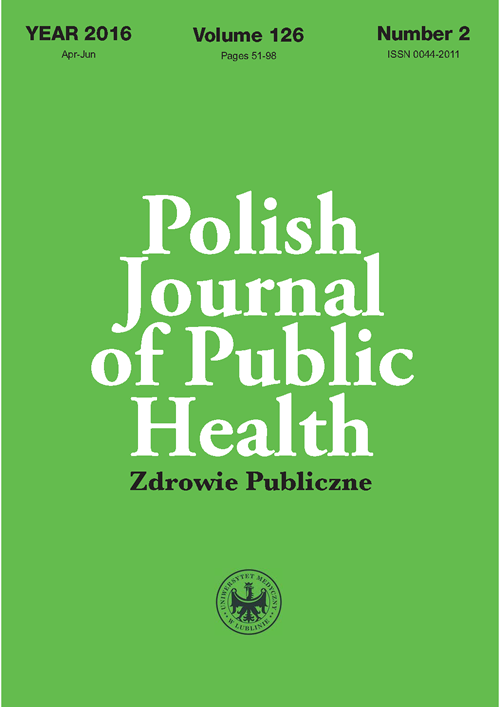Attitudes of women living in Otwock County toward breast cancer risk – prophylactic activity level
DOI:
https://doi.org/10.1515/pjph-2016-0013Keywords:
Breast cancer, Breast cancer prophylaxis, health-seeking behaviors among women, Otwock countyAbstract
According to ICD C-50 breast cancer (or disease of the nipple) is the second most frequent cause of death among women in Poland. It also ranks first among tumors. The number of cancer cases is on the rise, which is due to the fact that women are not involved in voluntary protection programs, they do not conduct breast self-examinations systematically and the fact that breast tumors are usually detected at an advanced stage. In order to improve these statistics, some anti-tumor programs, focusing on breast cancer, regular self-examination need to be implemented. It would definitely decrease the number of cancer cases and drive down the mortality indexes.
The authors of this article analyzed the health-seeking behaviors among female residents of Otwock county, paying special attention to the risk of breast cancer factors and disease prevention. This work is based on research conducted in 2014, looking at 69 women, residents of city of Otwock and Otwock area. An anonymous questionnaire designed by the authors of the study was handed out to the participants and the results were later subject to a statistical analysis.
The findings of the study suggest what follows: (i) gynecologists are not engaged enough in breast cancer prevention programs; (ii) women rarely conduct breast self-examinations, even though they know they have to do it at least once a month; (iii) women participate in preventive breast examinations relatively often; (iv) women would not be against mandatory mammography screenings; (v) the place of residence had no significant influence over one’s attitude toward prophylaxis; (vi) health education for girls should become a subject in junior high schools (gimnazjum in Polish).
References
1. Krajowy Rejestr Nowotworów
2. Mazowiecki Rejestr Nowotworów
3. Bucholc M, Łepecka-Klusek C, Karauda M, et al. Personel medyczny wobec edukacji kobiet w zakresie samobadania piersi. Zdr Publ. 2003;113(3/4):230-3.
4. Graja T, Grodecka-Gazdecka S. Czynniki wpływające na jakość życia kobiet leczonych z powodu raka piersi. Prz Gin Poł. 2005;5(3):115-20.
5. Chmaj-Wierzchowska K, Olejniczak T, Rabiega D, et al. Ocena profilaktyki chorób kobiecych i zachowań prozdrowotnych wśród żeńskiego personelu medycznego. Prz Gin Poł. 2005;5(3):125-9.
6. Sytuacja zdrowotna ludności Polski. Państwowy Zakład Higieny. Warszawa; 2012.
7. Nita R, Łeśniczak B, Słomka B, et al. Wiedza i zachowania zdrowotne kobiet z województwa łódzkiego w zakresie profilaktyki raka piersi. Pielęg XXI w.2010;1-2(30-31):5-8.
8. Pażdzior A, Stachowska M, Zielińska M. Wiedza kobiet na temat profilaktyki raka piersi. Now Lek. 2011;80(6):419-22.
9. Przestrzelska M, Knihinicka-Mercik Z, Kazimierczak I, et al. Zachowania zdrowotne kobiet profilaktyce nowotworu szyjki macicy i sutka. Onkol Pol. 2006;9:172-5.
10. Banach M, Grabiec M. Miejsce edukacji zdrowotnej w profilaktyce onkologicznej. Ann UMCS sectio D. 2005;60(16):1-4.
11. Smoleń E, Dobrowolska B. Wiedza pielęgniarek województwa lubelskiego i podkarpackiego w zakresie czynników ryzyka nowotworów piersi. Med Og Nauk Zdr. 2014;20(1):6-11.
12. Lewandowska A, Mess E, Laufer J. Profilaktyka raka piersi wśród kobiet.Onkol Pol. 2011;1:131-4.
13. Czekanowski R. Choroby gruczołu sutkowego. Menopauza. HTZ. Warszawa: Wyd. Med. Borgis; 2003.
14. Ślubowski T, Ślubowska M. Biomarkery w raku piersi. Część I. Receptory, czynniki wzrostu, geny i onkogeny. Wsp Onkol. 2007;11(4):167-74. 15. Kordek R. Co to jest nowotwór? In: A. Jezierski. Onkologia. Warszawa: PZWL; 2005. p.11-28.
Downloads
Published
Issue
Section
License
Copyright (c) 2016 Polish Journal of Public Health

This work is licensed under a Creative Commons Attribution-NonCommercial-NoDerivatives 3.0 Unported License.


